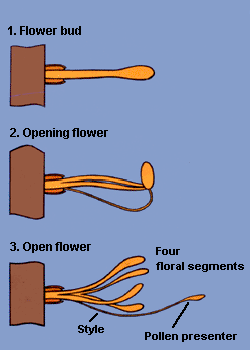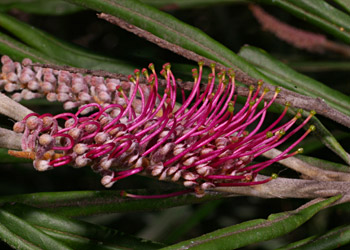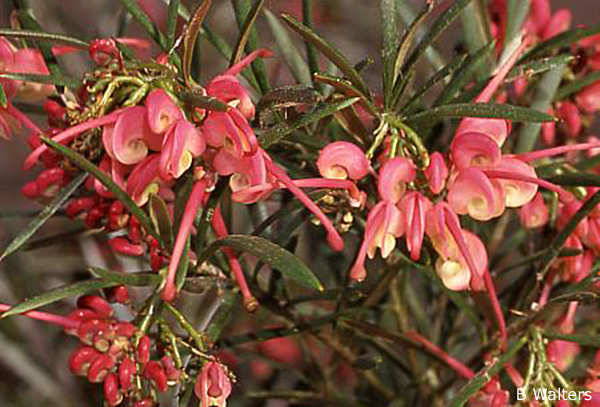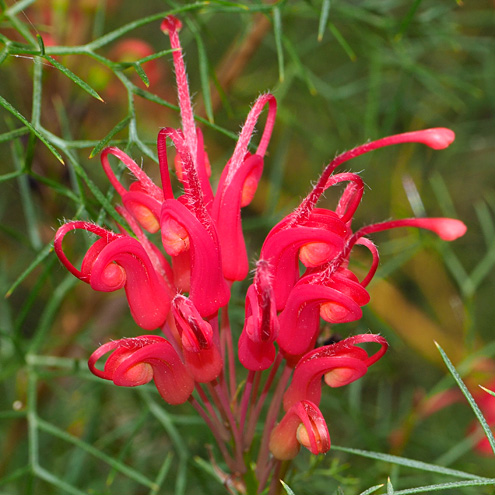Grevillea – Background
Introduction
The genus Grevillea is probably the most popular and widely cultivated of all of Australia’s plant genera. The reasons for this are not difficult to find. The plants occur in numerous shapes and sizes so that there is a Grevillea for almost any conceivable garden situation. Added to this are the colourful flowers which, in many cases, attract birds.
Grevillea is a member of the Protea family (Proteaceae) and its close relatives include Banksia, Hakea, Isopogon and Telopea (the Waratah). Grevillea is named after Charles Francis Greville who was one of the founders of the Royal Horticultural Society in 1804. There are over 300 species in the genus, most of which are endemic to Australia but a few species occur in Papua New Guinea and islands to Australia’s north.

Characteristics
The flowers of Grevillea species are quite small but they occur in clusters (an inflorescence) which, in some species, may consist of perhaps 100 or more individuals. The sequence of opening of each flower is similar to other members of the Proteaceae and goes through several stages as shown in the accompanying diagram (which is based on the opening of a Banksia flower).
- In bud, each flower appears as an elongated narrow tube (the perianth) comprising four segments each having an anther containing pollen at its tip.
- As the flower opens, the perianth segments separate to reveal a narrow style. Just before the flower fully opens the anthers transfer their pollen to the tip of the style (the stigma)
- Finally, the style separates from the perianth. At this stage the style and stigma, with attached pollen, is called a ‘pollen presenter’ (i.e. it is ‘presenting’ the pollen to a pollinator, usually a bird or small marsupial, which acts as the agent to transfer pollen from one flower to another for fertilisation.
 |
 |
|
| Left: ‘Spider flower’ arrangement of Grevillea speciosa Right: ‘Toothbrush flower’ arrangement of Grevillea asplenifolia Photos: Brian Walters |
||
The inflorescences can be quite variable in arrangement but two that are commonly recognised are the “spider” flower arrangement, in which the flower styles arise from a rounded inflorescence like the legs of a spider, and the “toothbrush” arrangement, in which the individual flowers are grouped into a short inflorescence along one side of the floral axis. Another common inflorescence, particularly in cultivated plants, is the large “brush” shape where the flowers are clustered into cylindrical racemes usually at the ends of branches where they are very conspicuous.
Grevilleas can be seen in flower at most times of the year but winter to early spring would be the peak flowering period. Following flowering, thin-walled seed pods develop, each containing one or two seeds. The pods open when the seed is mature. Seeds often have a papery wing to allow them to be distributed by the wind but this is not a universal feature. The majority of grevilleas occur in areas where bushfires are relatively frequent. Although a few can regenerate from lignotubers or epicormic buds after a fire, most are killed by fire and rely on seed germination for their continued survival.
Most grevilleas are small to medium shrubs but some are prostrate and a few can become large trees. The various species hybridise readily and most of the named cultivars and hybrids available in nurseries have resulted from chance hybridisation. Some deliberate breeding is being undertaken by Grevillea enthusiasts.
One of the great features of grevilleas in gardens (apart from the colourful flowers) is that many attract honey-eating birds which act as pollinators for the plants. A number of species rely on other methods of pollination, eg, beetles, moths, bees, ants, and even small marsupials.
Grevillea – Propagation
Introduction
Grevilleas are propagated by three principal methods; seed, cuttings and grafting. Tissue culture has also been used with a few species and cultivars but this is a more specialist method which is not of practical interest to most amateur growers. To maintain desirable characteristics of a particular plant, vegetative propagation (e.g. cuttings or grafting) must be used. This also applies to propagation of named cultivars.
Seed
As seed is shed annually, plants need to be kept under observation and seed capsules collected when they first begin to open.
Germination of seed of grevilleas can be slow and sometimes difficult. To assist germination a variety of seed pre-treatments have sometimes been attempted. Some of these work on some species but not on others.
The most usual method of pre-treatment is to ‘nick’ or peel off the seed coat with a sharp blade to allow moisture to reach the embryo. This needs to be done with care to avoid damage to the embryo. For seed with thin walls, pouring hot (not boiling!) water over the seed and allowing it to soak for a day or so is sometimes successful.
Seed can be sown in normal seed raising mixes and seedlings could be expected to appear in anything from 2 weeks to a year after sowing, depending on the species and the time of sowing. Those species native to temperate areas may not germinate in the heat of summer (this may be an ecological factor to enhance the chance of survival of the seedling in the wild). These species are best sown in autumn or early spring.
Cuttings
Propagation of Grevilleas from cuttings is generally a reliable method and is preferred over seed because of both the scarcity of seed and problems in germination. In addition, cutting-grown plants will usually flower at an earlier age than seedlings.
Cuttings about 75-100 mm in length with the leaves carefully removed from the lower half to two-thirds seem to be satisfactory. “Wounding” the lower stem by removing a sliver of bark and treating with a “root promoting” hormone both seem to improve the success rate. No special propagating mixes or treatments are required.
Grafting
Grevillea species native to one area of Australia may not thrive when grown in another area (this, of course, is not unique to grevilleas and is a factor to be considered with most Australian native plants). Because of this, a considerable amount of experimentation has been done, mainly by amateur growers, on grafting difficult species onto hardy root stocks. Although there is still much work to be done, the grafting of grevilleas has been most successful and is now a commonly used method by enthusiasts and is now also being used by commercial growers.
The most commonly used rootstock is the “Silky Oak”, Grevillea robusta, because it is easily grown from seed and is hardy under a wide range of conditions. Another popular rootstock is the cultivar G.”Poorinda Royal Mantle”. It has been found that not all species are compatible with these two stock plants and further investigations are needed.
General Propagation
Further details on general plant propagation can be found at the Society’s Plant Propagation Pages.
Grevillea – Cultivation
Introduction
With many different forms, growth habits and flower colours, grevilleas can be used for many different purposes in the garden. In addition, the flowers of many species and cultivars produce nectar and are excellent for attracting birds. Although grevilleas are popular garden plants, those species native to Western Australia are generally difficult to maintain for any length of time in areas of high summer humidity and rainfall (such as the eastern coastal strip of Australia). Similarly, eastern species may not thrive in the west.
Like most members of the Protea family, grevilleas have a distinctive root system (“proteoid roots”) consisting of tight groupings of many small “rootlets”. These are believed to enable the plants to more efficiently take up nutrients from the nutrient-deficient soils where many of the species occur naturally. In cultivation this means that the plants can be adversely affected by fertilizers, particularly phosphorus. It is generally recommended that grevilleas and other Proteaceae be fertilised only with low-phosphorus, slow-release fertilisers or not be fertilised at all.
 |
| A cluster of proteoid roots Photo: Brian Walters |
Virtually all species and cultivars perform best in well-drained soils and flower best in open, sunny positions. They prefer acidic soils.
Grevilleas respond well to regular, annual pruning where about one-third of the plant is removed. This promotes branching and produces a plant with a bushy shape. Some plants can be cut back severely if they develop a “straggly” shape. Some of the popular hybrids (eg G.”Robyn Gordon”, G.”Honey Gem”) are in this category. Others, however, will not tolerate this treatment. If in doubt, always leave some green foliage on the plant.
There are few serious pests that attack grevilleas. Borers may occasionally be a problem but will usually be noticed by the sawdust around the entrance to their tunnels. Inserting a piece of wire into the hole will often remove the pest, or the hole can be sealed with plastic wood. A variety of other pests such as caterpillars, sooty mould and scale may appear but they are no more of a problem on grevilleas than on any other plant and can often be ignored, allowing natural control methods (eg birds) to operate. If treatment is necessary, conventional pest control methods are suitable.
Allergic Reactions
The foliage of several grevilleas is known to cause skin irritations to individuals who are sensitive to compounds contained in the leaves. This occurs when the bare skin of sensitive individuals comes into contact with the foliage of the plants (contact dermatitis). Sensitivity varies considerably between individuals and between the different species and hybrids. The group of grevilleas most commonly implicated in causing contact dermatitis is the “Robyn Gordon” group of cultivars. As these are very popular in cultivation, care should be exercised in locating these plants in the garden – it would be best to avoid locating them where people would need to regularly brush past the plants and it would also be best to avoid planting them in school playgrounds.
Further information can be found in the article “Grevilleas as Plant Allergens“.
Rediscovering Grevillea rosmarinifolia
Peter Olde
The following article is reproduced from the newsletter of ANPSA’s Grevillea Study Group, March 2000. Peter is the leader of the Study Group.
One of the few plant species actually described by Allan Cunningham was Grevillea rosmarinifolia which appeared, along with several others, in Barron Field’s Geographical Memoirs of New South Wales (Pp.326-329).
Although Cunningham was a capable botanist himself and collected hundreds of species unknown to science during his time in Australia and New Zealand, most of his specimens and descriptive work was sent to Robert Brown who used his manuscripts and often even his manuscript names in his Supplementum Primum Prodromi Florae Novae Hollandiae published in London in 1830.
Cunningham’s Latin description of Grevillea rosmarinifolia was accompanied by the words “….A shrub of robust growth, and with reddish showy flowers. Banks of the Cox’s River.”
The rediscovery of this plant at the Type locality has been one of the holy grails of New South Wales botany, especially those associated with the genus Grevillea.
Grevillea rosmarinifolia is not a rare species, as circumscribed by McGillivray (1993). This circumscription is very broad and encompasses several population-based distinctive taxa. The species sens. lat. will soon the subject of a detailed revision. It is distributed on a wide range of soils ranging from basalt to granite and desert sands over a large area of both New South Wales and Victoria. Yet the form from the Cox’s River differs from all the others in having longer and broader, linear to narrowly lanceolate leaves.
 |
| The “type” form of Grevillea rosmarinifolia Photo: Brian Walters For information on the ‘type’ form of a species, see the footnote box |
There are few recorded collections of this taxon. The only specimens are those of Cunningham, collected in 1822. However, in a Catalogue of Plants cultivated at the Botanic Gardens, Sydney,New South Wales, January 1828, Charles Fraser indicates that G.rosmarinifolia was introduced there by himself in 1825. Indeed Fraser died while returning from Bathurst with a cartful of living plants in 1831.
The particular form of this species next appears between 1827-1828 in Robert Sweet’s Flora Australasica as an illustration of a plant growing at Mackay’s Clapton Nursery (United Kingdom). Sweet also informs us that it was first introduced at the Royal Botanic Garden at Kew, without explicitly stating by whom and how the plant was communicated.
In 1829, there appears another illustration from a “weak and starved” specimen at the Hackney Nursery, London. This can be found in Conrad Loddiges’ Botanical Cabinet: 15 where we are informed that the species had been in cultivation in England “since c. 1820”.
Subsequent sources give variable dates of introduction. Sweet (1827) says 1821 while Loudon (1830) says 1824, the latter date being the most likely since Cunningham did not collect it until 1822 as far as I can make out.
In Europe, Grevillea rosmarinifolia flourished in horticulture. There is evidence of its cultivation in Dusseldorf 1834, Florence 1854-55, Amsterdam 1857 and even Russia at Aksakov, 1860.
However, things on the ground at home were not too good. In a letter to Richard Cunningham accompanying the Type Sheet at K, Allan Cunningham recommends a visit to the grassy flat of the military depot (now known as Glenroy) where Governor Macquarie rested in 1815. Grevillea rosmarinifolia was to be found “on the flat at Cox’s River just below the Military depot on the immediate bank of that ?stream where also are to be observed G.sulphurea and G.canescens ….. if not destroyed by cattle”.
The place must once have been a haven for grevilleas. In a diary entry dated Friday 11th April 1817, Cunningham writes “At this river we first observed granite, of which its bed is composed. Grevillea acanthifolia and Grevillea asplenifolia (sic!), …., grow on the banks of this river in the greatest luxuriance.”
Several searches of the Type locality in the late 1960s and early 1970s failed to locate any plants of G.rosmarinifolia. Certainly no new collections have appeared in the specimen base at NSW, although specimens that differ in minor ways have been collected at Hampton and on the Kowmung River at Tuglow.
Then in a brief note that set interest soaring, D.J. (Don) McGillivray (1975) stated that “in August 1969, [he] observed a specimen of the type form of G.rosmarinifolia growing outdoors, beside a building in the Edinburgh Botanic Garden”.
Cuttings from the plant were sent to the Royal Botanic Gardens, Sydney, and specimens have been established in a number of gardens and some nurseries in New South Wales and Victoria. It is distinguished from other forms of the species by its longer, broader leaves, c. 2.5-4 cm long and 2-3 mm wide.
The very thought of a presumed-extinct Australian plant form being re-discovered at Edinburgh nearly half a world away and 1.5 centuries after it had presumably disappeared from its natural habitat was scarcely believable; but to have material returned from there to be re-introduced perhaps into the Australian wild was inspiring and exciting to say the least. Not only that but the re-discovery was such a fluke in itself.
The interpretive label on the living plant at Edinburgh Botanic Garden was Grevillea lanigera, and perhaps the only person in the world capable of recognising the taxon and its correct name and significance at that time happened upon it there by chance. The origin of the plant at Edinburgh is unclear. It may have been cloned from the original material at Kew which was communicated probably by Cunningham.
However, it may have been sent independently by Fraser, who was also a Scotsman and sent large amounts of material to Scotland during his tenure at the Sydney Botanic Gardens. For Fraser, indeed, this was part of his job description, as from 1823, he was officially known as “Superintendent Sydney Botanic Gardens” where he worked to collect and grow indigenous plants for the garden and to stabilise them for long voyages in a “plant cabbin” to grace the gardens of the King and also as a clearing house for exotics and fruit vines being introduced to the colony. In 1826, William Jackson Hooker published a description of Grevillea pubescens (syn. G.baueri subsp. baueri from a specimen grown from seed sent to him at Glasgow by Charles Fraser in 1822, flowering there in 1825.
Seed was also sent by Fraser to Dr Graham at Edinburgh Botanic Gardens. The truth is that we do not really know how or from what clone the Edinburgh material arose but we can surely be grateful that it had been maintained so successfully in cultivation for so long and that plants continued to survive outdoors in such a climate.
In Australia, meanwhile, the search for topotypical material continued. Between 1990 and 1999, individual members of the Grevillea Study Group – a part of the Australian Native Plants Society (Australia) – had conducted no less than four private and unofficial searches in the Hartley area.
As most of the area is now degraded, private farm land, these searches consisted of fence-peering and traipsing through road verges (no trespassing, of course!).
In November 1999, a Grevillea crawl was conducted in the area. On Saturday morning, November 6, while a number of the party travelled to Lithgow to vote for the republic that was not to be, Anders Bofeldt , Wollongong Botanic Gardens, decided to take a walk in the area where we had encamped the night before. On returning to camp, he asked innocently what this particular pink-flowered plant was that he had just collected.
The specimen was from a single plant that appeared to be about 30 years old, judging from the main stem which was the thickness of a man’s arm. Grevillea rosmarinifolia – rediscovered!
Bibliography
Cunningham A. (1825). A specimen of the indigenous botany of the mountainous country between the colony round Port Jackson and the settlement of Bathurst; Botany of the Blue Mountains in Barron Field’s Geographical Memoirs of New South Wales (P.328), John Murray, London.
Fraser C. (1828) A Catalogue of Plants cultivated in the Botanic Gardens, Sydney, New South Wales, January 1828. Unpub. MS.
Graham R. (1826) Dr Graham’s List of Rare Plants. Edinburgh New Philosophical Journal 1: 172-173, Adam Black, Edinburgh.
Hooker J. D. (1872) Grevillea rosmarinifolia. Botanical Magazine 98 Tab. 5971
Hooker W.J. (1826) Grevillea pubescens. Exotic Flora 3:t 216, London
Loddiges C. (1829) Grevillea rosmarinifolia. The Botanical Cabinet 15: t. 1479, Arch, London.
Loudon J.C. (Ed.) (1830) Hortus Britannicus Part 1: 39, Longman Rees, London.
McGillivray D.J. (1975) Australian Proteaceae: New Taxa and Notes Telopea 1(1):30
McGillivray D.J. assisted by R.O. Makinson (1993) Grevillea Proteaceae A Taxonomic Revision, Melbourne University Press, Carlton.
Olde P.M. & Marriott N.R. (1994) The Grevillea Book Vol.1:112-114, Kangaroo Press, Kenthurst.
Sweet R. (1827) Hortus Britannicus P. 348, James Ridgeway, London.
Sweet R. (1827-1828) Grevillea rosmarinifolia. Flora Australasica t.30, James Ridgeway, London.
| What is the ‘type’ form? |
|
When a plant is officially described and named, the description is based on a collected specimen of the plant. This specimen is often (but not always) the first specimen of the plant that was collected from its natural habitat. The specimen used for this official description is called the ‘type’ of the species. The process requires that a single specimen only be designated and this is called the holotype. Duplicates or parts of the original specimen are called isotypes and may be distributed to a number of herbaria throughout the world as reference material. The “type” form of a species is a plant collected from the same population as the holotype. Since Grevillea rosmarinifolia was collected by Allan Cunningham along the Coxs River, near Bathurst, New South Wales, plants from this population with similar appearance are known as the ‘type’ form. G.rosmarinifolia has a wide distribution and has many populations that differ significantly in appearance. It is important then to understand that the type form may differ in a number of characteristics from forms of the species found in other locations. These differences (eg, leaf shape and arrangement, flower structure) may sometimes be sufficient to warrant other forms or populations being described as separate taxa or species. In G.rosmarinifolia, there are in fact two subspecies. Subsp. rosmarinifolia remains as the type subspecies but subsp. glabella has been typified from a second population in western New South Wales. Like subsp. rosmarinifolia, it also has a ‘type’ specimen. Experts may disagree on the significance of the differences in the various forms of a species and, following research, it is not unusual for a new species to be “split” off from the type form. For example, Grevillea divaricata has recently been recognised as distinct from G.rosmarinifolia and been split off. |
Grevillea Study Group
The Grevillea Study Group is one of a number of Study Groups within the Australian Native Plants Society (Australia). Its aim is to further knowledge about the cultivation, propagation and conservation of members of the genus Grevillea. Members of the Group are mainly keen amateurs with no formal horticultural or botanical knowledge, although a number of professionals in those fields also participate. As in all study groups, the members’ work is mainly carried out in their own homes and gardens and in their own spare time but the Group also undertakes regular field excursions.
The Study Group has been in operation since 1978 and during that period over 100 detailed and informative newsletters have been published.
Further information about the Study Group, its activities and access to the newsletter archive can be found at the link below.
Grevillea – Further Information
Most books dealing with Australian native plants will contain useful information on the botany and horticulture of grevilleas. There are also a number of Grevillea resources on the internet. Some of the most detailed references are listed below.
Books:
- Burke, D (1983), Growing Grevilleas in Australia and New Zealand, Kangaroo Press, Kenthurst, New South Wales.
- Elliot, W. R and Jones D (1990), The Encyclopaedia of Australian Plants, Vol.5, Lothian Publishing Company Pty Ltd, Melbourne.
- McGillivray, D assisted by Makinson, R (1993), Grevillea, Melbourne University Press.
- Olde, P and Marriott, N (1994), The Grevillea Book, Vols.1,2,3, Kangaroo Press, Kenthurst, New South Wales.
- Wrigley, J and Fagg, M (1989), Banksias, Waratahs and Grevilleas, Collins Publishers, Australia.
Journals:
Several issues of the Society’s journal “Australian Plants” are particularly useful for those interested in Grevillea.
- Vol 9, No.75 June 1978; Grevillea in Horticulture.
- Vol 13, No.108 September 1986; Many species described with photographs.
- Vol 14, No.115 June 1988; Tropical Grevillea hybrids with photographs.
- Vol 18, No.144 September 1995; Three threatened Grevilleas with photographs.
- Vol.21 No.170 March 2002; Popular hybrids; Propagation by seed and grafting; Cinderella Grevillea; Illawarra Grevillea Park; Grevillea for cut flowers; New cultivars.
- Vol.21 No.173 December 2002; The Grevillea ‘Robyn Gordon’ complex; Some rainforest Grevilleas.
- Vol.22 No.181 December 2004; Allergy to Grevilleas.
Internet:
- Grevillea Study Group newsletters – past issues are available here.
- Grafting Grevillea caleyi.
- Grevillea beadleana; A grevillea lost for almost 100 years
- Grevilleas as Plant Allergens
- Grevilleas for Cultivation
- Grevillea ‘Golden Lyre’.
- Grevillea ‘Poorinda Royal Mantle’.
- Growing Native Plants – a series of plant profiles by the Australian National Botanic Gardens; includes a number of grevilleas.
- Invasive Grevilleas on The Ridgeway
- Propagation of Grevilleas by Grafting
- Pruning Grevilleas
- A Short History of Grevillea Cultivation in England
- Rediscovering Grevillea rosmarinifolia
- Tissue Culture of Grevillea species at Mt Annan Botanic Garden
- Three Rare Grevilleas
 Australian Native Plants Society (Australia)
Australian Native Plants Society (Australia)
